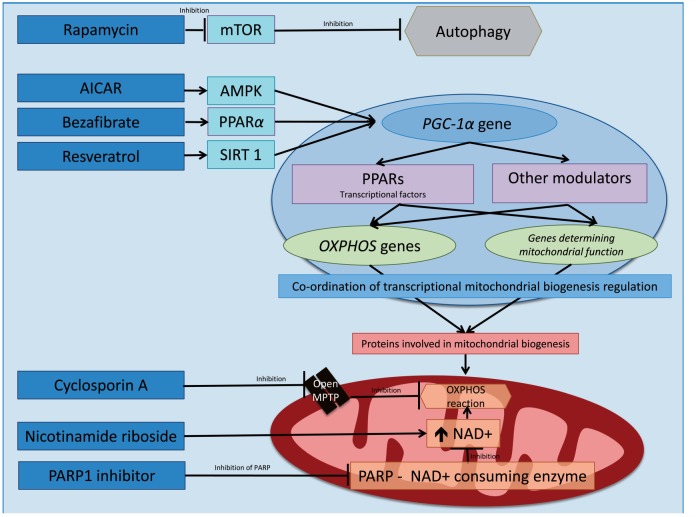Figure 4.
Schematic representation of pharmaceutical modulators of mitochondrial biogenesis. There are multiple signalling pathways involved in mitochondrial biogenesis. PGC-1α (encoded by PPARGC1A), which is a co-activator for a family of transcriptional factors known as PPARs, co-ordinates via a cascade of nuclear encoded proteins the vast majority transcriptional mitochondrial biogenesis. Novel pharmacological therapies aim to modulate PCG-1α mtDNA expression (e.g. PPARα) and protein expression or target downstream pathways. Bezafibrate is pharmacological ligand for the transcriptional co-factor PGC-1α. AICAR activates AMP-activated protein kinase (AMPK) and is thought to modulate increased mitochondrial biogenesis through PGC-1α. The natural polyphenol resveratrol activates sirtuin 1 (SIRT1). Sirtuins are part of a group of oxidizing NAD-dependent protein deacetylases. Upon activation, for example, by PGC-1α or transcription factor A, mitochondrial (TFAM) they promote mitochondrial respiratory chain activities and the transcription of genes modulating mitochondrial biogenesis and function. Nicotinamide riboside can be used to supplement NAD+ levels. PARP1 functions as a NAD+ consuming enzyme. Thus in turn inhibition of PARP1 has been demonstrated to increase NAD+ bioavailability and SIRT1 activity (not shown above) promoting oxidative phosphorylation. Rapamycin inhibits mTOR, which in turn releases mTOR inhibition of autophagy. Cyclosporin A inhibits the mitochondrial permeability transition pore (MPTP). Opening of the mitochondrial permeability transition pore is thought to deplete pyridine nucleotides thus impairing mitochondrial oxidative respiration.

